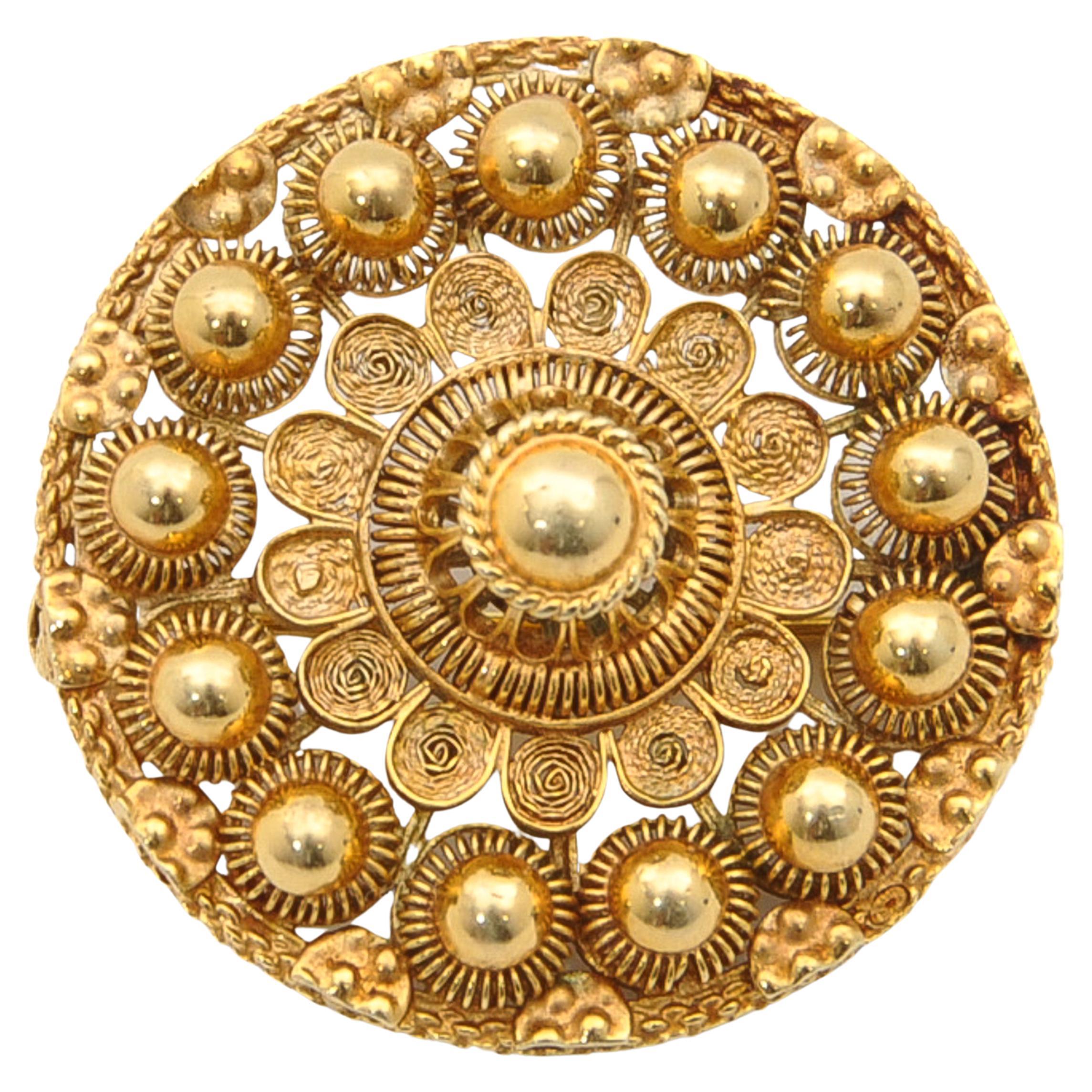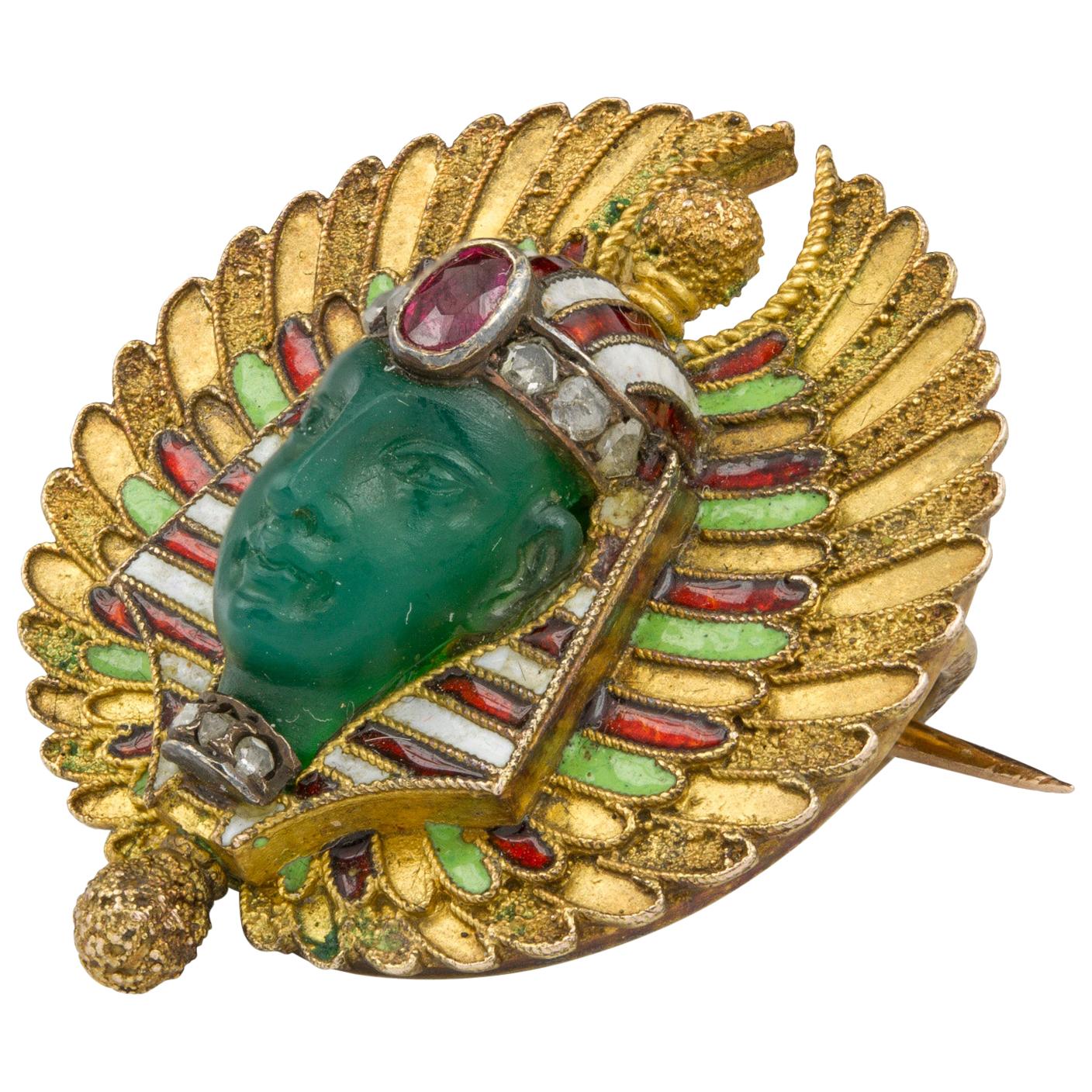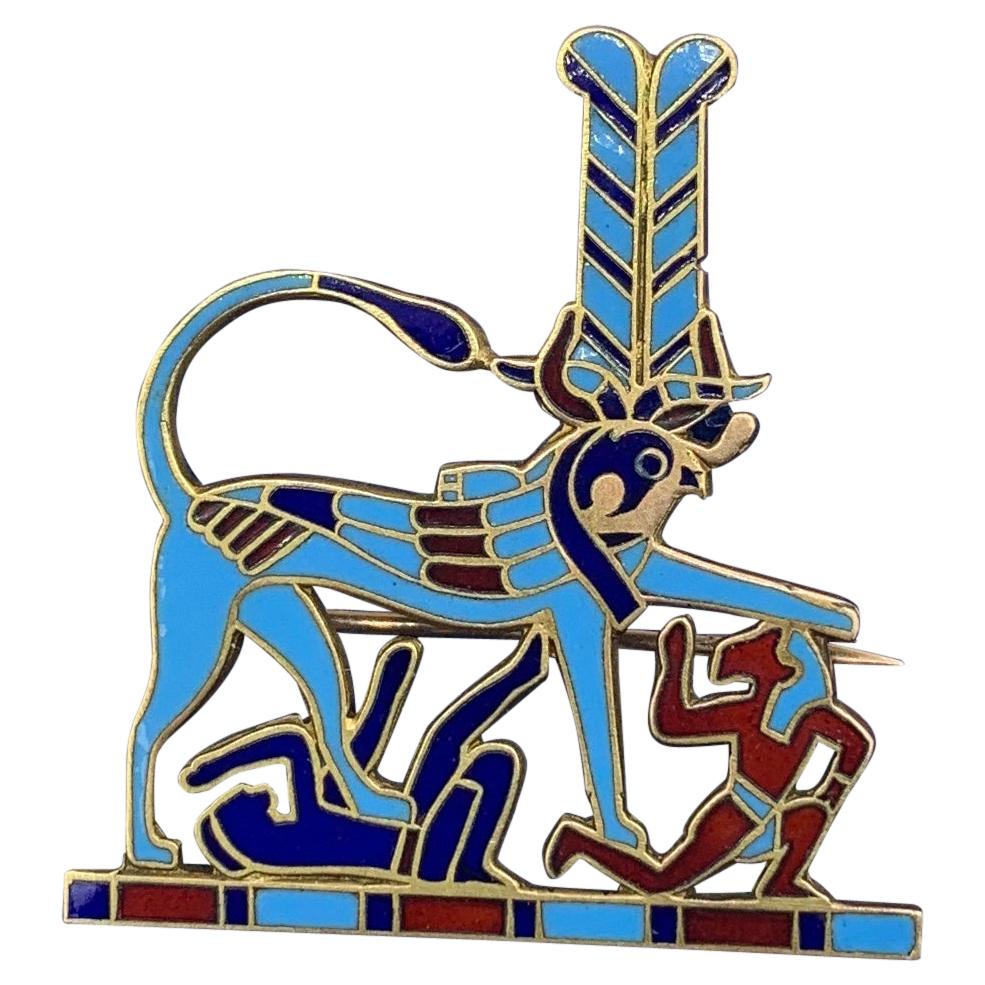Items Similar to Early 20th century Egyptian revival gold and enamel brooch
Want more images or videos?
Request additional images or videos from the seller
1 of 9
Early 20th century Egyptian revival gold and enamel brooch
About the Item
An early 20th century Egyptian Revival gold brooch, depicting a vulture centred with a faïence scarab, clutching lotus pods and surmounted with a cabochon ruby, polychrome enamel decoration overall and engraved to reverse, 3.5cm wide. One arrow missing.
Revival is always happening in the jewelry world.
The Indiana Jones inside all of us is always enticed by the buried loot of the ancients. It’s one of the reasons Egyptian Revival jewelry is so alluring.
Luckily for jewelry connoisseurs the span of history that have laid way to an aesthetic resurgence and intense interest in all things Egyptian during the last two hundred years.
Napoleon’s Egyptian campaign in 1798 ignited the West’s fascination with motifs we have all come to associate with Egyptian Revival—sphinxes, pyramids, palmettes, papyrus leaves. This curiosity was further stimulated by the excitement surrounding the completion of the Suez Canal in 1869, after 10 years of construction, arousing a real revival of the Egyptian style, with jewelers specifically incorporating artifacts that were thousands of years old, faience in the shapes of falcons and scarabs, set into jewels framed by vermilion enamel and lapis lazuli.
Some of the highlights in the 19th century timeline of Egyptomania include the opening of the Suez Canal in 1869, displays at World’s Fairs and the moment when Cleopatra’s Needle was erected in Central Park in 1881. The most famous 20th century Egyptian discovery occurred in 1922 when Howard Carter and his team unearthed the tomb of King Tutankhamen. Featuring hieroglyphics, scarabs, reeds and lotus flowers it inspired Tiffany, Cartier, and Van Cleef & Arpels among others to make Egyptian style designs.
In the imaginary world of the ancient Egyptians, the winged scarab represented the sun god Khepri and symbolized resurrection and immortality. Scarabs were worn as a talisman to protect humans from evil spirits, and these winged scarabs were placed on the chests of the dead, over their hearts and always face upwards, to serve as protection during the afterlife.
- Metal:Gold,Enamel
- Stone:Ruby
- Stone Cut:Cabochon
- Dimensions:Width: 1.38 in (35 mm)
- Style:Egyptian Revival
- Place of Origin:Europe
- Period:Early 20th Century
- Date of Manufacture:1920s, 30s
- Condition:Minor losses. One palmette missing.
- Seller Location:Malmö, SE
- Reference Number:1stDibs: LU3148218209272

About the Seller
5.0
Recognized Seller
These prestigious sellers are industry leaders and represent the highest echelon for item quality and design.
Platinum Seller
These expertly vetted sellers are 1stDibs' most experienced sellers and are rated highest by our customers.
Established in 2015
1stDibs seller since 2022
31 sales on 1stDibs
Typical response time: <1 hour
- ShippingRetrieving quote...Ships From: Malmö, Sweden
- Return PolicyA return for this item may be initiated within 3 days of delivery.
More From This SellerView All
- Antique early 20th century silver and paste lizard salamander broochLocated in Malmö, SEA fine antique early 20th century paste lizard or salamander brooch, artfully and expertly handcrafted in silver, partly gilt, workmanship c. 1900, in a fitted case, with the cutest ...Category
Early 20th Century English Victorian Brooches
MaterialsSilver
- A 19th century diamond and zircon rose broochLocated in Malmö, SEWhen the line between want and need becomes quite blurry. A 19th century 18 karat rose brooch set with an approx. 5ct blue zircon surrounded by 269 antique, old, table and rose cut ...Category
Antique Late 19th Century European Victorian Brooches
MaterialsDiamond, Zircon, 18k Gold, Yellow Gold, Silver
- Antique early 20th century opal bead and pearl necklaceLocated in Malmö, SE42 beautiful, gently graduated, multi-chromatic opal beads imbued with lightening flashes, alternate with small even sized pearls to create this enchanting necklace. The beads are ra...Category
Antique 1890s European Late Victorian Beaded Necklaces
MaterialsOpal, Pearl, 18k Gold, Platinum
- 19th century rock crystal and carved smoky quartz demi-parureLocated in Malmö, SEhis unusual and lovely victorian set of faceted rock crystals and carved smoky quartz was made in the second half of the 19th century. Natural rock crystals are saluted for its way of bending the light into a “pool” of light around the wearer. They are absolutely magical and look fabulous when worn. Rock crystal is the clear transparent variety of quartz (silicon dioxide) and has a MOHS hardness rating of 7. This makes them harder than, say, opal but softer than emerald (7.5) and topaz (8). Featuring two genuine rock crystal briolettes. The beautiful briolettes are pear shaped and faceted. They sparkle beautifully. Truly special heirloom earrings...Category
Antique Late 19th Century Dangle Earrings
MaterialsCrystal, Quartz, Rock Crystal
- David Webb wolf yellow gold and enamel earringsBy David WebbLocated in Malmö, SEDavid Webb the self-starter made it to New York and by 1948, at the age of 23, he opened shop. Manhattan was fast and fun: daytime visits to the Metropolitan Museum of Art, dinner parties with clients, and in 1962 he became First Lady Jackie Kennedy's choice to make the official Gifts of State. By the end of the 1960s, the smart set and all of Hollywood wore their David Webb animal...Category
Vintage 1960s American Stud Earrings
MaterialsGold, 18k Gold, Yellow Gold, Enamel
- Antique Early 19th Century Cut-Steel NecklaceLocated in Malmö, SECut steel jewelry was at the height of fashion from the mid 1700s well into the 19th century. Originated in the 1700s. Popular from the Georgian through the Victorian eras. To make cut steel, melted horseshoe nails were formed into tiny faceted beads. Those small steel gemstone-like studs were then riveted one-by-one onto a base plate. It was an English invention that quickly travelled throughout the world. Each stud could have up to 15 facets, and in general the finer and older the piece the more facets the studs will have. Improvements in candles meant that grand events and entertaining could take place at night. As diamonds are diamonds and not available for everyone, and everyone wanted to shine, the popularity grew. Cut-steel provided a stylish and popular new jewelry material that could be enjoyed by everyone at all levels of society. It grew beyond a simple imitation to an art in its own right. The manufacturing was complex and the workmanship that was required highly skilled. These were not mass produced objects. The studs were made from decarbonated cast steel, which was case-hardened, then the studs were faceted by cutting against a pewter wheel. Next were then polished with first fine emery and a hard brush, and then by hand with a special putty. Finally they were riveted onto pierced base plates which had to be drilled and cut by hand, too. The main place of cut steel production was Birmingham, England. And there, one manufacturer stood out from all the rest: Matthew Boulton. He had been born in 1728 into the industry — his father manufactured small metal products. But the younger Boulton had a special talent for marrying the latest technology with the latest fashion. He also was continually expanding — he even founded a mint. He wined and dined with dignitaries and advocated for his steel products. Fortuitously, he became quite close with the Russian ambassador to Catherine the Great. When the ambassador toured the mint, Boulton made sure to send the Empress some of his cut-steel necklaces. In 1759, Louis XV “encouraged” the nobility to donate their gold and gemstone jewelry to help fund the Seven Years War. The popularity of cut steel in France may in part have been due to these sumptuary laws which limited who could wear precious metals and diamonds. Either you complied with the law and gave up your family jewels to be melted down for the war chest...Category
Antique Early 19th Century English Early Victorian Link Necklaces
MaterialsSteel
You May Also Like
- Large Egyptian Revival Blue and Gold Enamel Pharaoh BroochLocated in London, GBLarge Egyptian Revival pharaoh brooch featuring blue and gold enamel. Measuring length 6.5 cm / 2.56 inches by width 4.8 cm / 1.9 inches. The brooch is in very good condition. There ...Category
Late 20th Century Egyptian Revival Brooches
MaterialsEnamel
- Early 20th Century Etruscan Revival 14K Gold Cannetille BroochLocated in Rotterdam, NLAn Early 20th Century 14 karat gold Etruscan Revival cannetille brooch. The brooch is designed with fine wire work decorated with cannetille. It feat...Category
Early 20th Century Dutch Etruscan Revival Brooches
MaterialsGold, 14k Gold
- 19th Century Egyptian Revival Pharaoh BroochLocated in London, GBAn 19th century Egyptian revival Pharaoh brooch, the chalcedony realistically carved as the face of the Pharaoh in a millegraine setting, wear...Category
Antique 1880s Austrian Egyptian Revival Brooches
MaterialsChalcedony, Diamond, Ruby, Enamel, 14k Gold, Yellow Gold
- 20th Century Enamel 18 Karat Yellow Gold BroochLocated in Poitiers, FRBrooch in 18 karat yellow gold, owl hallmark. Of oval shape, it is decorated with an enamel representing the Virgin Mary carrying a child in her arms, accompanied by Christ. The fram...Category
20th Century French Belle Époque Brooches
MaterialsGold, 18k Gold, Yellow Gold, Enamel
- Egyptian Revival Enamel Sapphire Ruby Gold Scarab BroochLocated in London, GBAn antique Egyptian revival scarab brooch, the cabochon-cut sapphire in a rub-over setting with rose cut diamond details, the outstretch...Category
Antique Late 19th Century Austrian Egyptian Revival Brooches
MaterialsDiamond, Ruby, Sapphire, 14k Gold
- 14 Karat Gold Enamel Egyptian Revival Brooch Heremakhet Horus HieracosphinxLocated in New York, NYThis is a rare Art Deco Egyptian Revival 14 Karat Gold and Enamel Brooch depicting Heremakhet (Greek: Harmakhis). Heremakhet is a Hieracosphinx who has the body of a lion and the he...Category
20th Century Unknown Contemporary Brooches
MaterialsGold, 14k Gold, Yellow Gold, Enamel
Recently Viewed
View AllMore Ways To Browse
Antique Jewelry 20th Century
Early 20th Century Jewlery
Antique Jewelry Of The 20th Century
Revival Jewelry
Revival Jewlery
Revival Jewellery
Most Famous Jewelry
Egypt Jewellery
Egyptian Jewellery
Egypt Jewelry
Egyptian Jewlery
30s Jewelry
Egyptian Jewelry
Gold Egyptian Jewelry
European Jewelers
Jewellery Discovery
Revival Style Jewelry
Ancient Egyptians Gold





